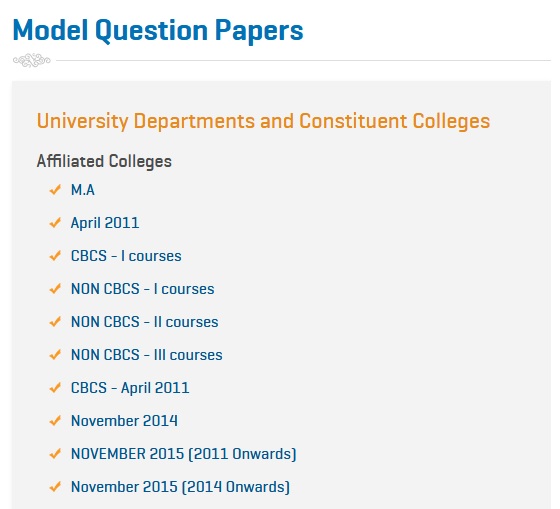Library And Information Science B.L.I.S Model Question Papers : alagappauniversity.ac.in
Name of the University : Alagappa University
Degree : B.L.I.S
Department : Library
Subject Code/Name : Library And Information Science
Document Type : Model Question Papers
Website : alagappauniversity.ac.in
Download Model/Sample Question Paper : Nov 2011 : https://www.pdfquestion.in/uploads/alagappauniversity.ac.in/4128.-1-B.L.I.Sc.,.pdf
Alagappa University Information Science Question Paper
B.L.I.Sc. DEGREE EXAMINATION,
Time : 3 Hours Maximum : 75 Marks
Part A (10 × 2 = 20)
Related / Similar Question Paper :
Alagappa University BLIS Fundamentals of Library & Information Science Question Paper
Information Science
All questions carry equal marks.
1. Explain the term information.
2. What are the primary sources of information-

3. Define information Explosion.
4. What is the difference between information and Knowledge-
5. Explain FIVE LAWS of library Science.
6. What are main objectives of ILA-
7. Explain term Jargon.
8. What is the publication of IASLIC-
9. Explain the important role of UNESCO.
10. Define Intellectual Property Rights.
11. (a) Define and discuss the concepts of data, information and knowledge.
(b) Explain the various aspects of information.
12. (a) Describe the barriers to information communication.
(b) Explain any Two Communication models.
13. (a) Explain the provisions of Delivery of Books and News Paper Act.
(b) Explain the functions of National Information Policy.
14. (a) Explain the important role of FID.
(b) Describe the major services of ALA.
15. (a) Explain the functions of ILA.
(b) Discuss the Third law of Library science and its implications.
16. Define Information and explain its characteristics, notion and properties.
17. Explain in detail about Information transfer cycle.
18. Discuss the important features of Library Legislation.
19. Discuss the objectives, functions and services of UNESCO.
20. Describe the growth and development of library and information
Information Processing — I
1. What is Class Number-
2. What are two types of common isolates-
3. What is Cow-Calf Principle-
4. Define Fission and Fusion.
5. What do you mean by subject device-
6. Expand UDC and DDC.
7. Define Systems and Specials.
8. What is Collection Number-
9. Define Mnemonics.
10. What is APUPA Pattern-
11. (a) Discuss the features of Analytico Synthetic and Enumerative
(b) Describe various kinds of Normative Principles.
12. (a) Mention the purpose for Principles of Facet Analysis.
(b) Explain Principles of Helpful Sequence in Colon Classification.
13. (a) Discuss the importance of Classification in organization of knowledge in Libraries. Or
(b) Enumerate the fundamental categories of Dr. S.R. Ranganathan and Explain them with suitable example.
14. (a) What is Notation and discuss briefly the Canons of Notation. Or
(b) Write an essay on ‘Systems’ and ‘Specials’ with suitable examples.
15. (a) Discuss Modes of Formation of Subjects in Colon Classification. Or
(b) Discuss the treatment of space in CC and DDC.

Part C : (3 × 10 = 30)
Answer any three questions.
All questions carry equal marks.
16. Define ‘Chain and Array’ and explain the canons for chain.
17. What is Phase Analysis? Describe with various types of phase Relations?
18. What is meant by characteristics of Division? Explain the Canons for Characteristics.
19. Explain the concept ‘Zone Analysis’ and describe its application in CC.
20. Trace the historical development of Library classification since 1876.
Information Processing — II
B.L.I.Sc. Degree Examination, November 2011 :
(Cataloguing And Indexing Theory) :
(CBCS – 2008 onwards) :
Time : 3 Hours
Maximum : 75 Marks
Part A : (10 × 2 = 20)
Answer all questions. All questions carry equal marks.
1. Expand POPSI and OPA.
2. What is pseudo series?
3. Define Thesaurus.
4. What is meant by tracing section?
5. Give two importance of bibliography.
6. What is ‘‘See and See also’’ entries?
7. Mention the areas in ISBC (G).
8. Define main entry.
9. Define canon of recall value.
10. What is chain indexing?
Part B : (5 × 5 = 25)
Answer all questions, choosing either (a) or (b). All questions carry equal marks.
11. (a) Discuss Catalogue Vs Bibliography. Or
(b) Explain the advantages and disadvantages of Dictionary Catalogue and Classified Catalogue.
12. (a) What is Chain Procedure? Discuss the application of Chain Procedure in deriving Class Index entries. Or
(b) Discuss post-coordinating indexing system.
13. (a) Explain Unit Card System. Or
(b) Discuss Compilation of Union Catalogue.
14. (a) Explain pre co-ordinate indexing system. Or
(b) Discuss uniterm indexing.
15. (a) Explain vocabulary control devices. Or
(b) Discuss MARC format.
Part C : (3 × 10 = 30)
Answer any three questions. All questions carry equal marks.
16. Mention the types of inner forms of catalogue with examples.
17. Compare the rules in CCC and AACR II for preparing the main entries.
18. To what extend POPSI has succeeded in overcoming the shortcoming of chain indexing system? Illustrate your answer with examples.
19. Explain OPAC. State how OPAC can help the reader in finding library resources.
20. Enumerate the various steps involved in construction of a thesaurus.
How can be a good speaker of English?
Introduction to computers